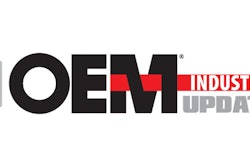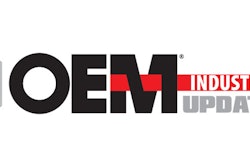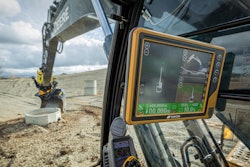
Each year, our State of the Industry issue looks at the top trends and technologies within the heavy equipment industries. We also dig into current and future market conditions, as well as regulations which may currently or in the coming years have an impact on how the industry will go about designing its equipment.
To get the best insights, we speak with executives from a variety of companies working in the industry—everyone from associations, to OEMs to component suppliers. Below are responses provided by Marcus King, Vice President of Off-Highway Global Sales, Business Development, Strategy, and Program Management, Dana Inc.
Read all of this year's executive Q&As.
Global Markets, Government & Trade
What are the key global markets your company sees as growth opportunities and why?
From both a geographic and market perspective, the U.S. construction sector is showing the greatest immediate promise, thanks to the Infrastructure Investment and Jobs Act. OEMs and suppliers from around the world are all actively looking for opportunities to support anticipated demand, especially given the lack of inventory.
The construction market was already on the rise thanks to pent-up consumer demand, the availability of cash for home improvements as a result of the pandemic, and major stimulus initiatives in countries around the world.
Additionally, we’re in the midst of a global agricultural boom due to robust commodity prices. This is driving demand for large tractors in the U.S. as well as smaller, lower horsepower four-wheel-drive tractors produced in India.
The strength of these markets is having an impact on ancillary markets as well, including mining. Commodities are going strong, especially rare earth metals used in electronics as well as alloys for steel production.
Also, the material-handling market is healthy due to the continued migration to online shopping. This is driving a need for the construction of warehouse capacity as well as demand for smaller lift trucks.
Beyond the U.S., the Chinese economy recovered quickly from the effects of the pandemic and has been doing well since 2020. In India, the market for low-horsepower tractors is prospering, and ongoing improvements to infrastructure are supporting the market for construction equipment there.
Are there any policies you are keeping your eye on that could impact (or have already impacted) your company and the industry?
Certainly, the Infrastructure Investment and Jobs Act in the U.S. is currently the single largest driver of activity, representing a level of spending that hasn’t been seen since the New Deal.
We’re also seeing a continued emphasis on sustainability through the reduction of carbon emissions, with regulations continuing to move forward despite the economic pause caused by the COVID-19 pandemic.
The movement toward more environmentally responsible business practices is not strictly mandated by government regulations, as many corporations are accelerating their efforts to reduce their greenhouse gas (GHG) emissions. For example, Dana announced in July the acceleration of our plans to reduce Scope 1 and 2 GHG emissions by at least 50% by 2030, which is ahead of our original target of 2035 that was announced in October 2020. We have also signed a commitment letter with the Science Based Target initiative (SBTi) to help set our future emissions targets.
The new target for 2030 brings forward our commitment to reduce more than 300,000 metric tons of carbon dioxide emissions annually.
Overseas, China’s commitment to the Belt and Road infrastructure initiative continues to bolster the construction and port equipment markets through its expanded network of railways, energy pipelines, highways, and streamlined border crossings that stretches from East Asia to Europe.
How, if at all, has the current state of the global trade tensions—particularly those between the U.S. and other countries—had an impact on your business?
For many years, we have positioned engineering, manufacturing, and support capabilities near our customers’ production facilities to help localize our offerings and accelerate products to market, so we are not significantly affected by trade issues.
Supply Chain Disruptions
How have supply chain disruptions impacted your business over the past year?
The greatest challenge for the industry in meeting demand has been the effectiveness of the supply chain, especially in the delivery of critical parts and components. While we have taken measures to solidify our relationships with suppliers to bolster our own supply chains, many off-highway OEMs have experienced major interruptions, such as the same semiconductor chip shortage that has impacted the automobile industry.
If impacted, what has your company done to try to overcome this industry challenge?
Supply issues have been amplified by the many challenges presented by the COVID-19 pandemic, and we’ve found that open and forward-looking communications with our OEM customers and our suppliers has been and will continue to be critical in planning production volumes in the short and long term. These lines of communication will be especially important if volumes spike in the immediate future.
To help us keep a laser focus on our suppliers and ensure we meet our commitments to customers, Dana implemented smart forecasting, which enables us to see our inventory across our supply chain for key components and the location of these products.
With this tool, we are able to flexibly respond to changing market conditions. For example, if one area of the world was impacted by a crisis, we could look across our supply chain to see where we might have materials or suppliers who could supplement our supply until the stress was alleviated in the original area.
We’re also alerted when inventories of certain components reach near critical levels so we can address the situation before it becomes an issue.
The smart forecasting capability was especially useful at the height of the COVID-19 pandemic, when regional supply chains were impacted at different times.
At what point do you foresee the current supply chain disruptions becoming less of an issue?
We expect pressures on supply chains for the near term, and some of the greatest challenges involve capital-intensive, process-related components. It takes time to bring on-stream capacity for components that present higher barriers to entry with long lead times on the equipment needed to manufacture them. While components such as castings and hoses may seem extremely commoditized, they can sometimes present the greatest risks within a given supply chain.
Diesel, Electric & Other Power Alternatives
How, if at all, do you see the role of diesel engines evolving in the coming years?
Hybrid, electric, hydrogen fuel cell, and natural gas will all play an important and growing role in the future of the commercial vehicle, off-highway, and industrial markets, but diesel will continue to play a significant role even as we reach out to 2040.
The commercial vehicle and off-highway markets—which currently are largely diesel—have made important progress over the last half century in improving emissions. Diesel powertrains will continue to compete in the total cost of ownership conversation as further weight reductions and efficiency improvements become available.
For example, our highly efficient hydromechanical variable transmission helps to reduce the fuel consumption of diesel-powered powertrains by enabling the engine to run at a consistent speed in its most efficient operating range in all duty cycles.
Also, Dana’s on-engine generator offers new vehicle architecture capabilities for off-highway hybrid applications where space constraints previously limited hybridization or engine downsizing. It offers improvements over competing technologies with respect to overall performance, physical packaging size, features, and flexibility.
Additionally, there are significant challenges in cost effectively establishing the electrification infrastructure for agriculture applications, so conventional powertrains will endure for the foreseeable future.
What alternative fuels do you foresee entering the heavy equipment industry in the next 5-10 years?
Hydrogen fuel cell technology is a potential fuel source, and our Dana Power Technologies team is already engineering and manufacturing fuel cell bipolar plates for hydrogen fuel cell stacks to meet the exacting requirements of our customers.
Earlier this year, we showcased our metallic and composite bipolar plate technology for fuel cell stacks at the 2021 Hannover Messe virtual tradeshow. Bipolar plates are an integral component for enhancing the performance of the fuel cell stack.
Manufactured using our patented integrated sealing technology and in-line conductive coating, Dana's ultra-thin metallic bipolar plates deliver superior power density, reliability, and durability and can cut fuel cell stack costs by up to 10%.
How will electrification—or other alternative energy/power systems—continue to advance in the heavy equipment industry?
We see electrification continuing to expand where e-Mobility systems deliver performance gains with a competitive total cost of ownership, and Dana has strategically invested to build on our more than a century of leadership in powertrain solutions.
In the past year, our acquisition of Rational Motion GmbH and investment in Pi Innovo LLC have further extended our ability to provide complete software, controls, integration, and engineering services to support our customers. These solutions position Dana to assist our customers during their transition to electrification and ultimately enhance the flexibility, robustness, efficiency, and safety of electric-vehicle systems.
Our wide and growing portfolio includes e-Drive technologies, thermal-management solutions, and integration capabilities that help OEMs improve the performance of new energy vehicles.
Additionally, we are developing e-Mobility and e-Motion systems across all the off-highway markets we serve, and we are supplying many of our customers with prototypes for testing. Off-highway OEMs are currently focusing on the electrification of compact equipment in construction, lift trucks used in warehouse environments, and underground mining vehicles where the cost of ventilation is driving the adoption of e-mobility solutions.
What new emissions regulations do you see on the horizon, and how might they impact future product development?
Zero emissions regulations in cities throughout Europe and California continue to move forward, and OEMs are seeking e-Mobility solutions for compact construction equipment that can still be used in urban environments, such as compact wheel loaders and electrified mini excavators.
Data, IoT & Connectivity
What will be the best use cases for the Internet of Things (IoT) and data in the coming years?
We see the best uses for IoT and data in their diagnostic and prognostic capabilities that provide live monitoring and alerts of various aspects of vehicle operations.
For example, Dana can leverage vehicle data through our Spicer Smart Suite™ platform of fully integrated, connected vehicle features. It converts operating data from the drivetrain into actionable insights for enhancing productivity, improving operator and machine safety, and reducing total operating costs.
In particular, the Spicer Smart Suite Intelligent Load Monitoring System (ILMS) uses patented and proprietary data-harvesting technologies across the vehicle to prevent tip-over incidents, supply intelligent calibration management, and estimate axle attitude. It is designed to alert the operator of potential tipping situations, reduce the risk of vehicle breakdowns, improve productivity, and enhance the long-term serviceability of drive systems.
We’re also developing Spicer Smart Suite connected technologies for traction-management and vehicle stability control, lubricant health monitoring and diagnostics, steering and suspension management, and data integration with vehicle communication protocols and telematics systems.
It’s critical that the systems we develop integrate with OEMs’ own vehicle diagnostic and telematics systems, allowing vehicle owners and operators to reduce the total cost of ownership through effectively managed machine operation and maintenance.
What potential do you see in the use of artificial intelligence and augmented/virtual reality—both for the design and manufacture of products as well as within equipment?
Artificial intelligence is a rapidly growing discipline that helps to reduce the time we spend in validation and bench testing by using data we’re already collecting throughout our engineering processes.
What advancements do you see on the horizon for connectivity and machine learning in the next decade?
Connectivity and machine learning can deliver significant productivity and efficiency gains by helping to optimize the behavior of operators, which is especially important given the ongoing departure of highly experienced operators from the workforce.
We’re seeing this in the use of our Spicer® HVT powersplit transmission in port environments. The Kalmar Global Eco Reachstacker is equipped with a Spicer HVT that uses dedicated software with machine-learning algorithms that enable the engine to run at a constant speed in all duty cycles. This reduces fuel consumption by up to 40% and increases productivity by up to 10% in a machine that operators enjoy driving.
What challenges remain for the continued adoption of data, IoT and connectivity related technologies or systems?
We see a few challenges that remain in the adoption of data-driven technologies for the off-highway mobility market. First is the sheer volume of data created, so the various steps in data management— capture, transmission, integration, analysis, storage, and dashboarding—must continue to evolve.
Standardization is also an issue, especially in mixed fleets and in environments where multiple autonomously operated vehicles are interacting.
Challenges & Opportunities
Are there any technologies or trends which you are currently excited about in the heavy-duty vehicle industry, or most looking forward to seeing in the coming years?
The off-highway market is in an interesting place at the present time. As e-Mobility technologies continue to expand and take hold in a gradual way, we also have to address rapidly growing customer demand with field-proven drive technologies that maximize the performance of conventional diesel-focused vehicle architectures predominant today.
To this end, we are excited about the Spicer® HVT, an advanced powersplit transmission that supplies significant advantages across the board over existing competitive conventional transmissions. It utilizes an advanced electronic control system to continually adjust the mix of hydrostatic and mechanical power, allowing the engine to maintain a consistent speed in its most efficient operating range.
This July, we launched the Spicer HVT1 specifically engineered for the unique duty cycles of agriculture telehandlers. It offers fuel savings of up to 30% when compared with agriculture telehandlers that use conventional transmissions.
Leveraging more than a decade of Dana expertise in developing hydromechanical variable transmissions for the off-highway market, the Spicer HVT1 offers exceptionally precise low-speed maneuvering control, smooth, progressive response for loading and handling cycles, and superior climbing and high-speed towing capabilities.
We’re also excited about our expanding portfolio of e-Mobility technologies for next-generation electric-driven vehicles. Our investment in resources to support the global shift toward electrification provides Dana with a large toolbox of offerings for the broad range of low- and high-voltage off-highway vehicle applications, including motors, inverters, controls and software, as well as thermal-management products for batteries and power electronics.
In particular, our Dana TM4® IPM technology for electric motors breaks new ground by opening new vehicle architecture capabilities for off-highway hybrid applications where space constraints previously impeded hybridization or engine downsizing.
We also have the deep expertise in house that helps us deliver fully integrated electric drive systems for a broad range of vehicle applications. We have ready access to nimble teams of mechanical, electrical, electronic, software, and mechatronic engineers, as well as powerful systems integration capabilities.
What do you think will be the biggest change to occur in the heavy-duty vehicle and equipment industries in the next decade?
We anticipate continued consolidation in the industry as OEMs and suppliers continue to develop systems enabling e-Mobility. We also expect to see a continued emphasis on complete, integrated system solutions.



















